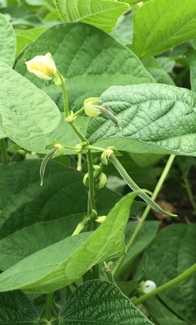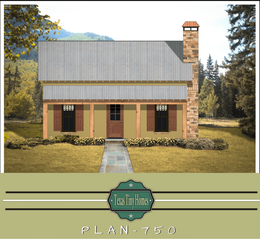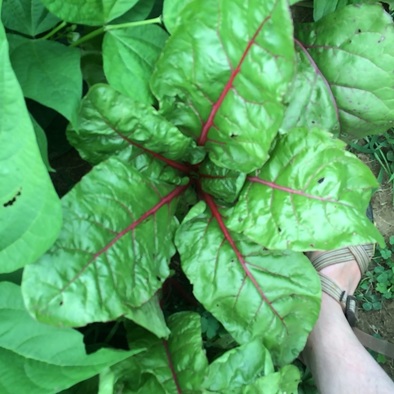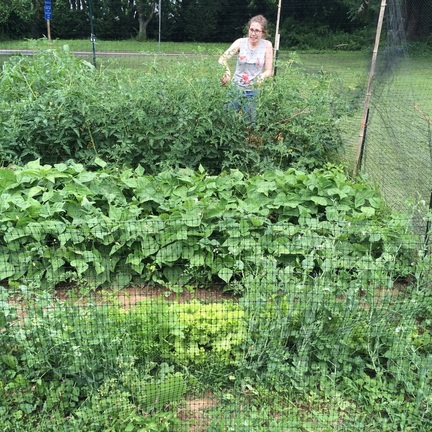Fruits of My Labor
 Baby beans! (Now eaten/canned)
Baby beans! (Now eaten/canned) - My verdict on row gardening
- Composting
- Garden pests
- Canning
- Other forms of preserving
- Food waste
- Gardening economics
- Lawns
- Plus some book reviews and miscellaneous historical finds
But First: The Ground Covered
 "Plan 750"
"Plan 750"
- Fenced in area = 18’ by 22’6’’ or 405 sq ft
- Lettuce bed = 6’6’’ by 2’8’’ or 17 and 1/3 sq ft
- Back bed = 5’ by 26’ or 130 sq ft
- Back-side/Lazarus bed = 10’ equilateral triangle or 43 and 1/3 sq ft
- Front herb beds = two right triangles, 11’8’' by 12’6’', or 146 sq ft
- Back porch pots = 13 to 25, avg. 8” diameter, thus 6.5 sq ft
The grand estimated total is just over 748 square feet.
For reference, this delightful home plan to the right is 750 square feet and includes two bedrooms, a bathroom, a family living room with fireplace and a normal-sized kitchen. Yeah, I've been gardening a house worth of square-foot-age.
I did notice some beds got more attention that others – even days I didn’t have time or energy to water the Victory Garden with the hose for 25 minutes, I often found ten minutes at a time throughout the day or evening when I could water the entirety of the pots, the Lazarus bed, the Lettuce bed, the back bed, or take a few watering cans to the front herb beds. The same, unfortunately, followed for weeding, reseeding, and pest control. Just like how you clean the kitchen most days and the living room once a week while the bedroom constantly flirts with chaos, right? (I can't be the only one...)
A Little Knowledge Can Be Dangerous ...
 Chard star!
Chard star! However, over the course of the summer I realized that I am definitely a first-year Victory Gardener. I ran out over-eager and over-ambitious -- especially in thinking I could keep up with the blog through the height of harvesting! Both bugs and rodents ate way more of our crops than their fair share (like our entire beet crop!), bacteria wilt got the cucumbers, weeds were more wild than ideal, and we definitely wasted seed when our stock accidentally baked out in a severe heat wave for five days -- and then wasted time and energy planting the dead seeds! In short, I became the twenty-first century embodiment of the World War II-era Department of Agriculture's greatest fears. The USDA encouraged scorn and mockery of those underprepared and under-committed to the task.
"We all recall the over-eager gardeners of the last war [...who] rushed into the field with hardly any preparation for their heroic labors, beyond looking up Agriculture in the dictionary to see what it meant"
Robbins, Leonard Harman. “15,000,000 Victory Gardens,” New York Times Magazine, August 23, 1942. Pg. 15.
 An unfortunately apt, if hyperbolic, excerpt. Ogden Nash, “My Victory Garden,” House & Garden, November 1943.
An unfortunately apt, if hyperbolic, excerpt. Ogden Nash, “My Victory Garden,” House & Garden, November 1943. The problem could be that, try as I might, I just couldn’t make myself strictly follow all the instructions from World War II. Some were impractical (plowing 100 pounds of various additives into the soil), some were dangerous (applying arsenates to my food crops), and some were just . . . more work than I was interested in (ergh, I know how to stake a tomato just fine!). I wasn’t great at following the instructions, or being a good, pliable pupil/gardener. But isn’t that what most Americans/people would do? Combine intuition with past experience with inspiration and take these instructions a healthy grain of salt? My failures may well be as instructive as my successes, I suspect (and hope).


 RSS Feed
RSS Feed